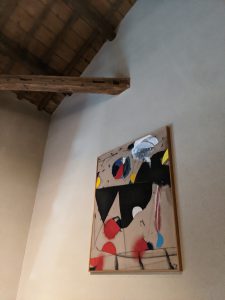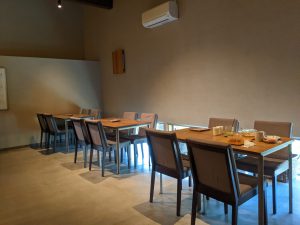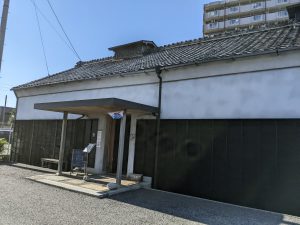日本茶蔵カフェ(愛知県古美術風光舎 骨董買取 古美術風光舎名古屋店)
2022.06.18
みなさまこんにちは、スタッフNでございます。
梅雨になり湿度が気になる季節になって参りましたね。
昨日部屋の湿度をアプリではかったら83%になっておりました。
除湿器を置きたいと毎年伝えているのですが、なぜか頑なにおいてくれません。
凍らせたペットボトルや、重曹を置いてちまちま頑張っております。
他に何かいい方法がございましたら是非教えてくださいませ。
さて、先日、半田市の日本茶カフェに行ってまいりました。

連れの用事に付き添ったのですが、せっかく半田まできたのだからこちらも何かをして帰りたい。
ということで、調べたところ雰囲気のあるカフェを発見。
奥まったところにあるので、調べていかないと気づきません。
2組並んでおりまして、閉店1時間前にもかかわらずcloseの看板を出しておりました。
この時は閉店早いなと思っておりましたが、1つずつ丁寧に準備するので時間がかかるようでございます。
元蔵を改造したカフェのようで天井が高く、広々としております。
声が響くからか、お客様も静かにしておられました。
せっかくだから普段飲んだことのないようなお茶にしてみようと思い、一番高い「天の誉」を注文。

自分で注ぐスタイルなのですが、はじめに店員さんから説明がございます。
大きなポットからまず手前の湯呑にいれ、それを急須にいれ40秒タイマーで測り、待ちます。
1杯目は用意されたお湯少しだけなのですが、それがとてつもなく甘くて美味でございました。
お茶は3杯ほど楽しめます。
一緒についてくる和菓子も美味でございました。
連れのほうじ茶は、また違う和菓子がついておりまして、お茶によって変えているのかもしれません。
日本茶がメインでしたが、他のお客様が皆かき氷を食べておりましたので私たちも注文。
知覚過敏と戦いながら、大量の氷を平らげました。
真ん中に小豆が入っており、飽きずに食べられます。

そこで今日は日本茶について調べてみました。
日本茶(にほんちゃ)とは、日常の会話で用いられる用語で、「日本のお茶」つまり「日本で作られたお茶」あるいは「日本でよく飲まれる種類のお茶」といった意味合いの言葉でございます。
緑茶はチャノキを発酵させずに作った不発酵茶の総称であり、日本茶=緑茶ではございません。
また、茶の植物学的な分類として定義された言葉ではございません。
ほとんどの日本茶は不発酵茶である緑茶ですが、ごく一部では中国茶の黒茶に近い発酵茶が製造されていて、漬物茶と呼びます。徳島県の阿波番茶、高知県の碁石茶、愛媛県の石鎚黒茶など四国に多くございます。四国以外には岡山県の玄徳茶、富山県のばたばた茶など。
不発酵茶とは早い段階で加熱することにより発酵を止める製法で、加熱方法によって種類がございます。
日本における緑茶は、蒸すことで加熱処理をして酸化・発酵を止めたのち、揉んで(揉まないものもある)、乾燥させる蒸し製という製法をとります。
蒸し製は日本の緑茶の特徴であり、世界的に珍しい茶葉の加熱方法でございます。
世界的には緑茶は釜で炒る加熱処理が一般的であり、中国茶で主に用いられます。
この製法をとる日本茶を釜炒り茶と言います。
釜炒り茶としては九州の嬉野茶やぐり茶などが有名でございます。
日本茶における緑茶を大分類すると中世までに確立した茶道における抹茶(挽茶)とそれ以外の、茶葉を挽かずに用いる広義の「煎茶」に分けられます。
狭義の「煎茶」とは、玉露(高級品)、番茶(低級品)の中間に位置づけられる、中級品の緑茶という意味です。
また本来の目的のお茶である本茶に対して、選別などの工程ではじかれた出物のお茶、すなわち茎茶、芽茶、粉茶、ティーバッグ用原料茶という分類も存在致します。
緑茶は学術的には不発酵茶とほぼ同義ですが、日本で一般に緑茶といった場合、単に日本で最も多く作られている緑茶すなわち煎茶(広義)を意味します。つまり煎茶(狭義)のほかに、玉露、番茶、ほうじ茶、玄米茶など全般を指します。
さらに広義には、抹茶を含める場合もあります。
日本では静岡県(牧ノ原台地・富士山麓・安倍川・天竜川・大井川など県下全域)にて日本の生産量の約40%が栽培されております。
山の斜面や肥沃な台地で多く栽培されているため、乗用の大型摘採機の導入などが難しく、跡継ぎ不足や高齢化が進む生産者にとって負担が大きいこと、急須で淹れる「リーフ茶」需要の低迷で、品質を売り物にしている静岡茶のニーズに合致しなくなったことを理由に年々生産量及び茶栽培面積の減少が続いております。
そのため、生産量において公表記録が残る昭和34年(1959年)から日本国内第1位である静岡県が、年々第2位の鹿児島県との差が縮まっている状況にあります。産出額においては令和元年(2019年)に鹿児島県が抜き日本国内第1位となり、静岡県は昭和45年(1970年)から49年間続いた首位の座から陥落致しました。
お茶と言えば静岡というイメージが強かったので、驚きです。
生産量第2位の鹿児島県は、知覧茶などの一部のブランドを除き、元々は温暖な気候をいかし紅茶の輸出用に広められました。
安価な海外製品に太刀打ち出来ず、苦しい状況に追い込まれ、1960年代に緑茶に転換致しました。
輸入自由化の後は、主に静岡県などの県外産の廉価品のブレンド用に生産されていたため知名度は浸透しなませんでした。
2000年代以降は需要が拡大するペットボトル飲料用向けに力を注ぎ、年に複数回収穫や平地を生かした機械化による大量生産、官民一体で効率的生産体制の整備やスマート農業の実用化をするなど生産量及び栽培面積を年々増やしております。
生産量第3位は三重県、第4位は宮崎県、他には室町時代から名を高めた宇治茶(京都府)、江戸の庶民に親しまれた狭山茶(埼玉県)、品質の高い玉露生産で名を高めた八女茶(福岡県)などがございます。
産地銘柄を表示する際には、当該府県産原料が50%以上含有するなどの条件を設け、ブランド維持を図っております。
現在、日本全国で栽培されている茶樹の9割を「やぶきた」一品種が占めております。最近では「おくみどり」「さえみどり」「つゆひかり」などの新しい品種の栽培に積極的な茶農家も増えてきており、特に鹿児島県では多様な茶樹栽培が活発でございます。
愛知県はというと、生葉収穫量4460トン、荒茶生産量908トン。県最大産地の新城のほか、西尾市(西尾、吉良)は碾茶の一大産地となっております。

茶は平安時代に中国から日本へ伝わりました。僧・栄西が鎌倉時代初めに『喫茶養生記』を将軍・源実朝に献上し、飲茶は寺僧や公家だけでなく武士、さらには豪商にも広まりました。水分補給や健康維持のために飲むだけでなく、文化としての茶道も確立。江戸時代になると、茶は町人・農民にも飲まれるようになりました。
平成初めまで、日本茶は家庭・職場で茶葉を入れた急須に湯を注いで作ることが普通でした。
喫茶店や甘味処では代金が必要な独立したメニューとして販売することもありましたが、多くの飲食店では食事をしやすくするために水とともに無料で提供されてきました。
飲料としてはコーヒーや紅茶、その他の清涼飲料と競合する面があり、伊藤園「お〜いお茶」など缶・ペットボトル入りの登場・普及により、日本茶は茶を入れる道具・時間がなくても飲めるようになりました。
こうした商品は温かくても冷たくても美味しいように抽出されているため、暑い夏場に麦茶と並んで緑茶を飲む習慣も定着し、現代においても日本茶は多く飲まれております。
日本茶には昔から、茶葉の産地や栽培・加工・抽出技術により品質・価格の差がありました。
近年は高級な日本茶への注目が高まっているそうです。
伊藤園は受注生産の高級品として『瓶 お~いお茶 玉露』を平成27年(2015年)に発売。
ロイヤルブルーティー社(神奈川県茅ヶ崎市)は1本数十万円のガラス瓶入り緑茶を販売しているそうです。
江戸時代初期の慶長15年(1610年)にオランダ東インド会社により平戸からヨーロッパへ初めて日本茶が輸出され、万治3年(1660年)にはロンドンの新聞に初めての茶の広告が掲載されております。
安政5年(1858年)に不平等条約である日米修好通商条約が調印され、翌年の横浜、長崎、箱館の開港により日本茶の輸出が始まります。
慶応3年(1867年)にはサンフランシスコと香港・日本をつなぐ太平洋航路も開通し、明治に入ると輸出量が激増、茶価も高騰しました。
主な輸出先はイギリスとアメリカで、明治末年まで生産量の60%以上を輸出していましたが、明治中期まで、再製所を欧米人が独占経営しており、日本の茶商は外人商社に売り渡すことしかできなかったため大きな利益とはならず、粗悪茶が横行し、明治16年(1883年)にはアメリカが日本茶の輸入禁止条例を発効、輸出は激減しました。
パリ万国博覧会 (1889年)に日本茶出品と茶店を開設し話題となりましたが、明治41年(1908年)にアメリカが輸入茶に高率な関税を課したことで日本茶は危機的状況を迎え、同時に、19世紀半ばにイギリスがインドなど植民地での茶の栽培を成功させたことで紅茶が主流になっていき、そのイギリス植民地産紅茶がアメリカ市場へも進出し、日本茶の輸出量は減少していきました。
第一次世界大戦勃発でイギリス植民地産紅茶の代替として日本茶の需要が高まり、大正6年(1917年)には最大の輸出量を記録し、アメリカ向けにその80%が輸出されたが、戦後アメリカ市場から閉め出されて再び低迷、ニューヨーク万国博覧会 (1939年)で日本茶を積極的に宣伝するなどしたが、第二次大戦で生産量そのものも減少し、戦後は緑茶の輸入自由化により初めて輸出量が輸入量を下回る結果となりました。
21世紀に入り、高級品を含めて、日本茶は世界的な健康志向や和食ブームを背景に、海外でも愛飲されるようになっております。
日本茶の中心である緑茶の輸出額は平成28年(2016年)に過去最高の約115億円と、10年前の3倍近くに増えました。
日本茶を出す欧米風カフェも増えているほか、使う茶葉を農園単位でこだわったり、ハンドドリップで入れたりする高級な日本茶専門店も登場しております。
まさに今回行ったお店のことですね。
最近では〇〇専門店などこだわったお店が増えてきています。
日本茶について詳しく知らなくても、手軽にカフェで最高級茶葉を堪能できるなんて素敵ですね。
最高級茶葉を堪能するには、やはりそれなりの食器で飲まねば・・・。
さらに古美術に興味がわいてまいりました。
おうち時間、急須やお皿などにこだわってなんちゃって一人お茶会をしてみるのもいいかもしれません。
古美術風光舎の湯呑で優雅なひととき、いかがでしょうか?
ではでは

Hello everyone, this is Staff N.
The rainy season has come and the humidity is a concern.
Yesterday, the humidity in the room was 83% when I measured it with the app.
I tell him every year that I want to put a dehumidifier, but for some reason he doesn’t do it stubbornly.
We are doing our best with frozen PET bottles and baking soda.
By the way, the other day, I went to a Japanese tea cafe in Handa City.
I accompanied my companion’s errand, but since I came to Handa, I would like to do something and go home.
So, when I looked it up, I found a cafe with an atmosphere.
It’s in the back, so you won’t notice it unless you look it up.
Two groups were lined up, and even though it was one hour before the store closed, there was a close sign.
At this time, I thought it would be early to close, but it seems that it will take time to prepare carefully one by one.
It looks like a cafe remodeled from the original storehouse and has a high ceiling and is spacious.
The customer was quiet, probably because the voice echoed.
I decided to make a tea that I wouldn’t normally drink, so I ordered the highest “heavenly honor”.
It’s a style of pouring by myself, but the clerk first explains.
From the big pot, first put it in the teacup in front of you, put it in a teapot, measure it with a 40-second timer, and wait.
The first cup was just a little hot water, but it was extremely sweet and delicious.
You can enjoy about 3 cups of tea.
The Japanese sweets that came with me were also delicious.
Hojicha with my companion comes with different Japanese sweets, so it may be different depending on the tea.
Japanese tea was the main product, but we also ordered it because all the other customers were eating shaved ice.
He flattened a large amount of ice while fighting hypersensitivity.
There is azuki beans in the middle, so you can eat it without getting tired.
So today I searched for Japanese tea.
Japanese tea is a term used in everyday conversation, meaning “Japanese tea”, that is, “tea made in Japan” or “a type of tea that is often drunk in Japan”. ..
Green tea is a general term for non-fermented tea made without fermenting tea plants, and Japanese tea is not green tea.
Also, it is not a term defined as a botanical classification of tea.
Most Japanese tea is green tea, which is unfermented tea, but a small part of it is fermented tea that is similar to black tea, which is Chinese tea, and is called pickled tea. There are many in Shikoku such as Awabancha in Tokushima Prefecture, Goishicha in Kochi Prefecture, and Ishizuchi Black Tea in Ehime Prefecture. Other than Shikoku, Gentoku tea from Okayama prefecture, Batabata tea from Toyama prefecture, etc.
Non-fermented tea is a manufacturing method that stops fermentation by heating at an early stage, and there are different types depending on the heating method.
Green tea in Japan is steamed to stop oxidation and fermentation, then knead (some are not kneaded) and then dried.
Steamed tea is a characteristic of Japanese green tea and is a rare method of heating tea leaves in the world.
Globally, green tea is generally heat-treated by roasting in a kettle, and is mainly used in Chinese tea.
Japanese tea that uses this method is called Kamairicha.
Ureshinocha and Guricha from Kyushu are famous as Kamairicha.
Green tea in Japanese tea can be broadly classified into matcha (ground tea) in the tea ceremony established by the Middle Ages and other broadly defined “sencha” that is used without grinding tea leaves.
In the narrow sense, “sencha” means intermediate green tea, which is positioned between gyokuro (luxury) and bancha (low-grade).
In addition to the original purpose of tea, there is also a classification of tea that has been rejected in processes such as sorting, that is, Kukicha, Mecha, Konacha, and raw tea for tea bags.
Academically, green tea is almost synonymous with unfermented tea, but when we say green tea in Japan, it simply means green tea, or sencha (in a broad sense), which is the most commonly made in Japan. In other words, in addition to sencha (narrow sense), it refers to gyokuro, bancha, hojicha, genmaicha, etc. in general.
In a broader sense, it may also include matcha.
In Japan, about 40% of Japan’s production is cultivated in Shizuoka Prefecture (Makinohara Plateau, foot of Mt. Fuji, Abe River, Tenryu River, Oi River, etc.).
Since it is cultivated a lot on mountain slopes and fertile plateaus, it is difficult to introduce a large passenger plucking machine, which is a heavy burden for producers who are short of succession and aging, and demand for “leaf tea” brewed in teapots. Due to the slump in tea, the production volume and tea cultivation area continue to decrease year by year because it no longer meets the needs of Shizuoka tea, which sells quality.
Therefore, since 1959, when the public record of production remains, Shizuoka Prefecture, which is the number one in Japan, is narrowing the gap with Kagoshima Prefecture, which is the second largest in Japan year by year. In terms of output, Kagoshima Prefecture was overtaken in the first year of Reiwa (2019) to become the number one in Japan, and Shizuoka Prefecture fell from the top position that had continued for 49 years since 1970.
Speaking of tea, I was surprised because I had a strong image of Shizuoka.
Kagoshima Prefecture, which has the second largest production volume, was originally popularized for black tea exports due to its warm climate, except for some brands such as Chiran tea.
I couldn’t compete with cheap overseas products, and I was forced into a difficult situation, so I switched to green tea in the 1960s.
After the liberalization of imports, the name did not penetrate because it was mainly produced for blending low-priced products from outside the prefecture such as Shizuoka prefecture.
Since the 2000s, we will focus on PET bottled beverages, whose demand is expanding, and mass-produce by mechanization that makes use of harvesting and flat land multiple times a year, establish an efficient production system by the public and private sectors, and put into practical use of smart agriculture. We are increasing the production volume and cultivation area year by year.
The third largest production volume is Mie prefecture, the fourth is Miyazaki prefecture, and Uji tea (Kyoto prefecture), which has been famous since the Muromachi era, Sayama tea (Saitama prefecture), which is familiar to the common people of Edo, is of high quality. There is Yame tea (Fukuoka prefecture), which has made a name for itself in the production of gyokuro.
When displaying the brand of origin, we set conditions such as containing 50% or more of the raw materials produced in the prefecture to maintain the brand.
Currently, one variety of “Yabukita” accounts for 90% of the tea plants cultivated all over Japan. Recently, the number of tea farmers who are active in cultivating new varieties such as “Okumidori”, “Samidori” and “Tsuyuhikari” is increasing, and especially in Kagoshima prefecture, various tea tree cultivation is active.
In Aichi prefecture, the yield of fresh leaves is 4460 tons and the production of crude tea is 908 tons. In addition to Shinshiro, the prefecture’s largest producer, Nishio City (Nishio, Kira) is one of the largest producers of Tencha.
Tea was introduced from China to Japan during the Heian period. At the beginning of the Kamakura period, the monk Eisai presented “Coffee Yosei-ki” to the shogun Minamoto no Sanetomo, and drinking tea spread not only to temple monks and officials but also to samurai and even wealthy merchants. Not only drinking for hydration and maintaining health, but also establishing a tea ceremony as a culture. In the Edo period, tea was also drunk by tradesmen and farmers.
Until the beginning of Heisei, Japanese tea was usually made by pouring hot water into a teapot containing tea leaves at home or at work.
At coffee shops and sweets shops, it was sometimes sold as an independent menu that required a price, but at many restaurants, it was provided free of charge with water to make it easier to eat.
Beverages compete with coffee, black tea, and other soft drinks, and with the advent and widespread use of cans and PET bottles such as Itoen’s “Oi Ocha,” Japanese tea has no tools or time to make tea. You can now drink.
Since these products are extracted so that they are delicious whether they are hot or cold, the habit of drinking green tea alongside barley tea in the hot summer has become established, and even today, many Japanese teas are drunk.
Japanese tea has long had differences in quality and price depending on the tea leaf production area and cultivation / processing / extraction techniques.
In recent years, attention has been increasing to high-class Japanese tea.
Itoen released “Bottle Oi Ocha Gyokuro” as a made-to-order luxury product in 2015.
Royal Blue Tea Co., Ltd. (Chigasaki City, Kanagawa Prefecture) sells green tea in glass bottles for several hundred thousand yen each.
The first Japanese tea was exported from Hirado to Europe by the Dutch East India Company in 1610 in the early Edo period, and the first tea advertisement was published in a London newspaper in 1660. We are doing it.
The Treaty of Amity and Commerce between Japan and the United States, which is an unequal treaty, was signed in 1858, and the export of Japanese tea began with the opening of Yokohama, Nagasaki, and Hakodate the following year.
In 1867, the Pacific route connecting San Francisco with Hong Kong and Japan was opened, and in the Meiji era, exports increased sharply and tea prices soared.
The main export destinations are the United Kingdom and the United States, which exported more than 60% of the production until the end of the Meiji era. Since it could only be sold to Japan, it was not a big profit, and inferior tea was rampant. In 1883, the United States entered into an import ban on Japanese tea, and exports fell sharply.
Japanese tea was exhibited and a tea shop was opened at the Paris World Exposition (1889), and it became a hot topic. At the same time, as the United Kingdom succeeded in cultivating tea in colonies such as India in the middle of the 19th century, black tea became mainstream, and the British colonial tea entered the American market, and Japanese tea. Export volume has been declining.
With the outbreak of World War I, the demand for Japanese tea as an alternative to British colonial tea increased, and in 1917 it recorded the largest export volume, 80% of which was exported to the United States. After the war, it was shut out from the American market and was sluggish again, and it actively promoted Japanese tea at the New York World War II (1939), but the production itself decreased in World War II, and the import liberalization of green tea after the war. For the first time, the export volume fell below the import volume.
Entering the 21st century, Japanese tea, including luxury goods, is becoming a favorite drink overseas due to the global health consciousness and the Japanese food boom.
The export value of green tea, which is the center of Japanese tea, reached a record high of about 11.5 billion yen in 2016, nearly triple the value of 10 years ago.
The number of Western-style cafes that serve Japanese tea is increasing, and there are also high-end Japanese tea specialty stores where you can stick to the tea leaves you use on a farm-by-farm basis or put them in by hand drip.
It’s exactly the store I went to this time.
Recently, the number of specialty stores is increasing.
It’s wonderful that you can easily enjoy the finest tea leaves at a cafe without knowing more about Japanese tea.
In order to enjoy the finest tea leaves, you have to drink with proper tableware.
I have become more interested in antique art.
It may be a good idea to have a tea party by yourself, sticking to your teapot and plates at home time.
How about an elegant time with a cup of antique art Fukosha?
See you soon
****************************
梅雨のひと時、整理お片付けなどをされている方も。
風光舎では、古美術品や骨董品の他にも絵画や宝石、趣味のお品など様々なジャンルのものを買受しております。
お片付けをされていて、こういうものでもいいのかしらと迷われているものでも、どうぞお気軽にご相談下さいませ。
また風光舎は、出張買取も強化しております。
ご近所はもちろん、愛知県内、岐阜県、三重県その他の県へも出張いたします。
まずは、お電話お待ちしております。
愛知県名古屋市千種区・骨董 買取
『古美術 風光舎 名古屋店』
TEL052(734)8444
10:00-17:00 OPEN

